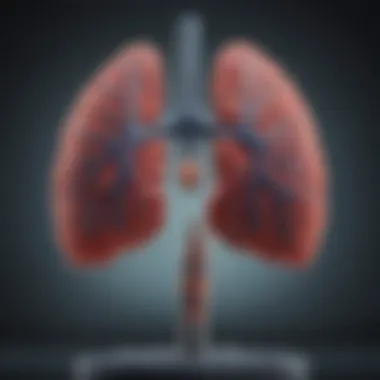Understanding Non-Small Cell Lung Cancer Statistics


Intro
Non-small cell lung cancer (NSCLC) is more than just a medical term; it is a diagnosis that resonates with many individuals and families across the world. Each statistic about NSCLC, every survival rate, and incidence figure tells a story of struggles, resilience, and hope. Digging into the baffling world of cancer, one typically encounters a multitude of data points that can be overwhelming. However, understanding this data is paramount, especially for those affected directly or indirectly by this illness.
Lung cancer stands as one of the leading causes of cancer-related deaths, emphasizing the necessity of awareness and education around this ailment. Recognizing the trends in diagnosis and treatment can aid in addressing this public health crisis. This is not merely about numbers; it’s about lives impacted, choices made, and advancements sought to improve life outcomes. The nuances of NSCLC, from its forms to its treatment pathways, merit a closer examination, as advancements continue to shape the landscape of oncology.
In this article, we aim to dissect the statistics surrounding NSCLC, exploring incidence rates, survival figures, and demographic information to provide an in-depth understanding. By tracing the historical context and current research, we will clarify not just the what but also the why, generating insights that serve a spectrum of stakeholders—from healthcare providers to patients.
Article Overview
Purpose of the Article
The primary aim of this piece is to furnish a detailed statistical analysis of NSCLC. Through examining various figures, we intend to enlighten our audience on patterns and trends over the years. With information sourced from robust studies and health databases, our objective is to present a well-rounded view of the NSCLC landscape. It’s about understanding the familiar as well as the unfamiliar aspects of this type of lung cancer.
Relevance to Multiple Disciplines
The prevalence of lung cancer impacts not just oncologists or pathologists; it interweaves through several fields including epidemiology, public health, and patient care. Thus, the importance of this information stretches across various sectors. Health educators can rely on these insights to develop awareness campaigns. Researchers may find avenues for further study, and healthcare practitioners can utilize this data to inform treatment approaches and patient interactions.
Research Background
Historical Context
Diving into history, lung cancer has evolved from a comparatively rare disease to one that claims millions of lives globally each year. NSCLC itself accounts for nearly 85% of all lung cancer diagnoses, making it vital to focus on this subtype for understanding trends in lung cancer overall. The spike in incidence rates correlates closely with smoking patterns and environmental factors, which are worth scrutinizing in our review.
Key Concepts and Definitions
To navigate the statistical maze effectively, one must grasp certain definitions:
- Non-small cell lung cancer: A category of lung cancer that includes several subtypes, including adenocarcinoma, squamous cell carcinoma, and large cell carcinoma.
- Incidence rate: This refers to the number of new cases of NSCLC diagnosed within a specific timeframe, typically represented per 100,000 individuals.
- Survival rate: This indicates the percentage of patients who live for a specific period following a diagnosis, often expressed at intervals of one, five, or ten years.
Understanding these terms provides a foundation for interpreting the statistics and discussions that follow in this comprehensive overview.
Prolusion to Non-Small Cell Lung Cancer
Non-small cell lung cancer, often abbreviated to NSCLC, feeds into a larger narrative about public health. This topic isn't just a bunch of statistics on paper; it's a real-world concern that affects thousands of lives every day. Understanding NSCLC is crucial, not just for individuals dealing with this diagnosis, but also for the healthcare providers and researchers who aim to combat it. As we dive into the intricacies of this condition, it's essential to recognize the urgency of accurate statistics in shaping effective treatment and prevention strategies.
Definition and Classification of NSCLC
NSCLC encompasses a variety of lung cancer types that aren’t small cell carcinoma. It’s commonly classified into three major categories: adenocarcinoma, squamous cell carcinoma, and large cell carcinoma.
Adenocarcinoma
This type usually originates in the outer parts of the lung and is often associated with smoking but can also occur in non-smokers. It is the most common form of NSCLC, accounting for nearly 40% of all lung cancer cases.
Squamous Cell Carcinoma
Often linked with smoking, squamous cell carcinoma tends to arise in the central parts of the lungs, especially in the bronchi. This form constitutes about 25–30% of NSCLC cases.
Large Cell Carcinoma
Characterized by larger, abnormal cells, large cell carcinoma can appear in various regions of the lungs. Although it’s less common, it spreads aggressively, making it particularly dangerous.
These classifications are vital for determining treatment strategies and prognosis, highlighting how different forms can influence patient care. Each type has its unique morphological characteristics and can respond differently to therapies. Notably, these distinctions also help in educating patients about their particular diagnosis, fostering a better understanding of their condition.
Importance of Statistics in Cancer Epidemiology
When we talk about statistics in the realm of cancer epidemiology, we're addressing the bedrock of informed decision-making. Statistical data illuminates patterns and trends, providing a clearer picture of how widespread NSCLC truly is and who is most affected.
With respect to NSCLC, relevant statistics shed light on several key areas:
- Incidence and Prevalence: Knowing how many new cases are arising annually helps in resource allocation for treatment facilities.
- Demographics: Insights into age, gender, and ethnic backgrounds allow for tailored outreach and support services that can address specific needs.
- Treatment Outcomes: Data shows how various treatments impact survival rates, which can guide future approaches and research initiatives.
Access to solid statistical evidence forms the cornerstone of effective public health strategies.
Access to solid statistical evidence forms the cornerstone of effective public health strategies.
In summary, the statistics surrounding NSCLC not only drive scientific research but also influence policy changes in cancer care. They serve as a compass for healthcare providers, researchers, and even patients, leading the way toward better treatment and outcomes.
Understanding the depth of this topic is essential; it goes beyond mere numbers into the realm of improved lives.
Global Incidence of NSCLC
Understanding the global incidence of non-small cell lung cancer (NSCLC) is crucial for various stakeholders, including public health officials, researchers, and patients. This section sheds light on how frequently NSCLC occurs worldwide, providing insights into patterns that can inform strategies for prevention, diagnosis, and treatment.
Recent data indicates that NSCLC accounts for nearly 85% of all lung cancer cases. Thus, grasping the factors influencing global incidence of this cancer type can help experts tailor effective public health interventions. It's vital to analyze how geographic, economic, and socio-political factors shape these statistics.
Prevalence Rates by Region
The prevalence of NSCLC varies significantly across different regions, influenced by a multitude of factors such as healthcare access, smoking rates, exposure to environmental toxins, and awareness of lung cancer symptoms.
For instance, North America and Western Europe exhibit relatively high incidence rates, which can be attributed to higher smoking prevalence, along with better diagnostic facilities that catch more cases. Conversely, regions like sub-Saharan Africa report lower rates, possibly due to underdiagnosis and differing healthcare infrastructures.


- North America:
- Asia:
- Europe:
- High incidence (60 cases per 100,000 population)
- Smoking remains a primary risk factor
- Varying rates; countries like China report high statistics due to industrial pollution and smoking.
- India shows rising cases owing to an increase in urban migration and poor air quality.
- Western Europe has robust cancer registries showing significant prevalence, whereas Eastern Europe presents underreported figures due to less comprehensive healthcare systems.
Statistical data from organizations like the Global Cancer Observatory can provide more concrete numbers for each region, allowing for a nuanced understanding of NSCLC's global terrain.
Temporal Changes in Incidence
Analyzing temporal changes in the incidence of NSCLC lays bare the trends over the years, revealing important relationships between societal behavior and cancer occurrence. For instance, during the latter half of the 20th century, as smoking became more widespread, the rates of lung cancer, particularly NSCLC, soared. Today, however, public health campaigns have successfully reduced smoking rates in several countries, and the data reflect a corresponding decline in new cases.
- Pre-2000s: Dramatic rise in cases linked primarily to widespread smoking.
- 2000s-2010s: Introduction of stringent anti-smoking laws in various regions led to observable decline in incidence.
- Present Day: While some regions show a decline due to public awareness and regulations, others are still on the upward tick due to increasing exposure to carcinogens, such as air pollution.
"The rise and fall of lung cancer statistics often tells more about societal changes than it does about the disease itself; understanding this helps us frame effective interventions."
"The rise and fall of lung cancer statistics often tells more about societal changes than it does about the disease itself; understanding this helps us frame effective interventions."
Through both historic and contemporary lenses, it becomes clear that the battle against NSCLC is both an ongoing challenge and a testament to the progress achieved in public health frameworks. The interplay of demands from various regions, coupled with advancements in treatment and diagnosis, paints a comprehensive picture that warrants continued research and understanding.
Demographic Variations in NSCLC Statistics
Understanding the demographic variations in non-small cell lung cancer (NSCLC) statistics is crucial for multiple reasons. Variation in the incidence and outcomes of NSCLC across different demographic groups sheds light on underlying risk factors, access to healthcare, and potential biases in research. By dissecting these variations, researchers and healthcare providers can tailor interventions that address specific needs of populations most affected.
The examination of demographic trends also elevates awareness regarding how age, gender, and ethnicity influence the cancer landscape. This can enable public health strategies that focus on education, prevention, and early detection aimed at specific groups, leading to improved outcomes.
Moreover, recognizing disparities can assist in policy-making aimed at reducing the gap in cancer care among differing demographics. Understanding these variations is not just about statistics; it is about doing something meaningful with that data.
Age and Gender Disparities
Age and gender significantly influence the prevalence and prognosis of NSCLC. Statistically, older individuals show a higher incidence of lung cancer, which is likely linked to prolonged exposure to risk factors like smoking and environmental pollutants. For instance, most NSCLC cases are diagnosed in people over the age of 65.
In terms of gender, there are notable differences. Historically, men have had higher rates of NSCLC, but this gap has been closing in recent years, particularly in younger populations. This can be attributed to changing smoking behaviors and increased awareness regarding lung health among women.
Key Points about Age and Gender Disparities:
- The average age of diagnosis leans heavily towards older adults, often presenting challenges in treatment due to comorbidities.
- Gender differences highlight that although men are at a higher risk, the alarming rise in cases among women suggests a need for targeted awareness and screening programs.
"The shifting demographics of lung cancer patients illuminate the importance of continuous research to tackle age and gender-specific risk factors."
"The shifting demographics of lung cancer patients illuminate the importance of continuous research to tackle age and gender-specific risk factors."
Racial and Ethnic Differences
Racial and ethnic differences in NSCLC incidence and outcomes are pivotal in understanding the broader picture of lung cancer epidemiology. Research indicates that Black Americans have higher rates of lung cancer compared to their white counterparts, despite similar smoking rates. This disparity might be influenced by socio-economic factors, access to healthcare, and genetic predispositions.
Hispanic and Asian populations tend to have lower rates of NSCLC, although this varies based on geographic location and lifestyle factors. For example, a high prevalence of non-smokers developing adenocarcinoma, a subtype of NSCLC, has been observed in some Asian countries.
Noteworthy Elements Regarding Racial and Ethnic Differences:
- Access to Care: Minority groups often face barriers in healthcare access, leading to late-stage diagnoses.
- Cultural Factors: Social stigmas and beliefs may impact treatment acceptance and adherence in racial communities.
Understanding these demographic variables is not merely academic; it can drive better healthcare policies, focused educational campaigns, and improved care strategies, ultimately leading to enhanced patient outcomes.
Survival Rates and Prognosis
Understanding the survival rates and prognosis of non-small cell lung cancer (NSCLC) is critical for several reasons. First, it provides patients and their families with essential information regarding outcomes and expectations, allowing them to make informed decisions about treatment options. Furthermore, survival statistics serve as valuable benchmarks for researchers and healthcare professionals, as these figures can highlight the efficacy of various treatment modalities over time. By analyzing these rates, we can identify patterns that may influence patient care strategies.
With the complexity surrounding NSCLC, survival rates are often segmented into different strata, reflecting variations based on treatment, age, and demographic factors. Prognosis in cancer varies significantly; thus, grasping the intricacies behind the average survival statistics is crucial for navigating the choices patients face after a diagnosis.
Five-Year Survival Statistics
Five-year survival rates are a central focus in oncology for patients diagnosed with NSCLC. These statistics represent the percentage of patients still alive five years post-diagnosis, a crucial timeframe that serves as a pivotal indicator of treatment success and disease management. According to recent data, the five-year survival rate for NSCLC can fluctuate, often hovering around 25% across all stages combined, but this number can be misleading without considering the stage at which the cancer is diagnosed.
- Stage I is often associated with a significantly higher five-year survival rate, reaching approximately 70% - 80%, as the cancer is localized and more manageable.
- In contrast, patients presenting with Stage IV NSCLC often face a grim outlook, with five-year survival rates plummeting to about 5%.
The stark differences in these percentages underscore the importance of early detection, highlighting how crucial regular screenings and awareness can be in catching the disease before it advances.
Factors Influencing Prognosis
Numerous factors can affect the prognosis of a patient diagnosed with NSCLC. Some of these factors include:
- Stage of Cancer: As mentioned, the stage at diagnosis is perhaps the most influential determinant in survival rates. Early-stage cancers, when confined to the lungs, tend to have far better outcomes than late-stage, metastatic cases.
- Patient's Overall Health: A patient's age and general health condition, including the presence of comorbidities like COPD or heart conditions, significantly influence treatment options and overall prognosis. Younger patients with fewer health problems generally fare better.
- Histological Subtype: NSCLC is diverse, which means the specific subtype—whether adenocarcinoma, squamous cell carcinoma, or large cell carcinoma—can impact treatment response and expected survival. Some subtypes are known to be more aggressive than others.
- Treatment Type: The nature of treatment also plays a critical role. Those receiving targeted therapies, immunotherapy, or effective chemotherapy might show improved outcomes compared to traditional treatments, particularly in cases of advanced disease.
"Early detection is key. The sooner a patient is diagnosed, the better the prognosis."
"Early detection is key. The sooner a patient is diagnosed, the better the prognosis."
Overall, survival rates and prognosis present a complex but vital picture of the landscape surrounding NSCLC, emphasizing the need for ongoing research in treatment advancements and public health initiatives to enhance awareness and detection. As we look ahead, the integration of these statistics into holistic patient care will be paramount for improving outcomes.


Advancements in Diagnostic Techniques
The landscape of diagnosing non-small cell lung cancer (NSCLC) has undergone significant transformation in recent years. These advancements have improved the accuracy and speed of detection, essential elements that often determine the effectiveness of treatment plans. Early diagnosis remains a critical factor for favorable outcomes in patients, and understanding the various innovations can provide insight into their implications for clinical practice and patient care.
Screening Methods and Early Detection
Detection of NSCLC in its early stages is key. Screening methods often utilized include low-dose computed tomography (LDCT), which has showcased the ability to identify lung nodules at a nascent stage. Unlike traditional X-rays, LDCT captures more detailed images, making it possible to catch abnormalities sooner.
- Benefits of LDCT:
- Significantly reduces mortality in high-risk groups, such as long-term smokers.
- Enables identification of smaller tumors that might go unnoticed in regular screenings.
Furthermore, new blood-based biomarkers are coming into play, representing a shift toward liquid biopsies. These tests analyze circulating tumor DNA and can detect genetic mutations associated with lung cancer, providing a non-invasive option for screening. However, while promising, the efficacy of these biomarkers requires further validation to ascertain their generalizability across diverse populations.
Role of Imaging Technologies
Imaging technology plays a pivotal role in not only the initial detection of NSCLC but also in monitoring the disease progression over time. Techniques such as magnetic resonance imaging (MRI) and positron emission tomography (PET) scans are enhancing diagnostic conversations among healthcare professionals.
- Advantages of Imaging Technologies:
- MRI helps in assessing the extent of the tumor and its effect on surrounding tissues, offering critical information for staging.
- PET scans can reveal metabolic activity of cancer cells, thereby helping to identify whether a lesion is benign or malignant.
The integration of artificial intelligence (AI) in analyzing imaging results is also reshaping diagnostics. AI algorithms can facilitate quicker readings and improved precision, reducing human error. However, clinicians must exercise caution as these technologies are continually evolving, necessitating ongoing training and adaptation to ensure optimal use.
“The ability to identify lung cancer at an earlier stage could lead to more treatments options and improve survival rates significantly.”
“The ability to identify lung cancer at an earlier stage could lead to more treatments options and improve survival rates significantly.”
Treatment Modalities for NSCLC
The discussion surrounding treatment modalities for non-small cell lung cancer (NSCLC) is crucial. It serves not only to understand how this form of lung cancer is managed but also sheds light on how different approaches can affect patient outcomes. There's a multitude of choices in treating this condition, so knowing the ins and outs of each method can mean the difference between life and death.
Surgical Interventions
Surgical interventions form the cornerstone of NSCLC treatment, especially in early-stage diagnoses. If the tumor is localized and hasn’t spread to other parts, surgery can often completely remove the cancerous tissue. One common approach is lobectomy, where a lobe of the lung is removed. This is typically the preferred method due to its effectiveness.
Another option is pneumonectomy, involving the removal of an entire lung; this is less common and usually reserved for larger or more aggressive tumors. There’s also wedge resection, where only a small section of the lung is excised. This decision isn’t made lightly and factors in the overall health of the patient and the tumor's characteristics.
However, surgery isn’t without its drawbacks. The recovery can be lengthy, and there’s always the risk of complications, such as infections or respiratory issues.
"Surgical options play a pivotal role in offering patients a potential cure, especially when caught early."
"Surgical options play a pivotal role in offering patients a potential cure, especially when caught early."
In some cases, doctors may recommend combining surgery with other treatment modalities, such as chemotherapy or radiation, to improve the chances of a complete recovery. This multidisciplinary approach underscores the importance of tailoring treatment to the individual patient’s circumstances.
Radiation Therapy Statistics
Radiation therapy is often used as an adjunct to surgery or when surgery isn’t feasible. It focuses on killing cancer cells by damaging their DNA. For many patients, external beam radiation therapy is the standard approach. Here, high-energy rays are precisely aimed at the tumor, minimizing the impact on surrounding healthy cells. The stats are compelling:
- About 50-60% of NSCLC patients receive radiation therapy at some point in their treatment
- Studies show that combining radiation with chemotherapy can enhance survival rates by approximately 30% for certain patients
Moreover, stereotactic body radiation therapy (SBRT) has emerged as a promising alternative, particularly for smaller tumors. This method delivers high doses of radiation in very few sessions.
This treatment can be particularly beneficial for older patients or those with significant comorbidities, offering a non-invasive option that avoids some of the physical tolls of surgery.
Chemotherapy and Targeted Therapies
Chemotherapy has been a staple in treating NSCLC for decades. It works by using potent drugs to kill fast-growing cells, including cancer cells. Traditionally, doctors would prescribe a combination of drugs, often referred to as platinum-based chemotherapy — techniques utilizing drugs like cisplatin or carboplatin. The statistics reflect this:
- Chemotherapy often extends survival by about 2-3 months in advanced stages of NSCLC
- For a significant subset of patients, particularly those with certain genetic mutations, targeted therapies can provide hope. Medications like erlotinib or crizotinib have shown promising results in specific populations, leading to responses in 60-70% of cases where these mutations are present.
The key factor here is that biology matters. Not every patient will respond uniformly, and the presence of biomarkers can greatly influence treatment choice. Liquid biopsies are also paving the way for non-invasive testing, allowing for the identification of specific genetic anomalies that guide therapy decisions.
Epidemiological Trends Over Time
Understanding the epidemiological trends over time is crucial in the study of non-small cell lung cancer (NSCLC). It not only provides insights into how the disease has evolved, but also sheds light on factors contributing to its incidence and mortality rates. By analyzing historical data alongside recent findings, researchers and healthcare professionals can gauge the effectiveness of current treatment methods and public health initiatives.
A significant aspect of studying these trends involves recognizing changes in the demographics of patients over the years. For instance, the rise in lung cancer instances in younger populations prompts further investigation into potential underlying causes, whether they relate to lifestyle changes or increased exposure to risk factors.
Moreover, tracking these trends aids in forecasting future patterns, which can ultimately guide resource allocation and policy-making. Accurate statistical analyses of past and present data can highlight critical areas requiring targeted interventions to curb the incidence and improve survival rates.
Longitudinal Studies and Their Findings
Longitudinal studies have proven indispensable in the examination of NSCLC trends. These studies make it possible to observe the same groups of individuals over extended periods, thus capturing data on how individual factors interact with broader population dynamics. Such comprehensive insights can reveal patterns related to age, gender, and smoking history, effectively painting a picture of the evolving landscape of NSCLC.
One notable study indicated a marked change in the risk of NSCLC over the past few decades. The analysis showed that while smoking rates may be declining in some regions, alternative risk factors such as air pollution and secondhand smoke exposure are becoming more significant contributors to lung cancer cases. Furthermore, researchers noted changing diagnostic criteria that can affect reported rates of incidence.
In addition, longitudinal studies often provide a platform for assessing the effectiveness of newer treatments over time. By comparing data from earlier treatment methods with those currently in practice, researchers can ascertain whether advancements in therapy truly impact patient outcomes.
Impact of Public Health Initiatives


Public health initiatives play a vital role in shaping epidemiological trends for non-small cell lung cancer. Campaigns aimed at reducing smoking prevalence have shown varying degrees of success across different regions. As tobacco control measures have tightened, the incidence of NSCLC in certain populations has begun to decline.
Programs like the CDC's "Tips From Former Smokers" campaign have reached diverse audiences, promoting awareness about the dangers of smoking and the benefits of quitting. These initiatives underscore the importance of targeted messaging tailored to specific communities. Consider the impact of grassroots organizations, which often mobilize local efforts to provide support and resources to those grappling with smoking addiction.
Additionally, access to screening and early detection has improved due to enhanced public health strategies. With increased awareness, more individuals are seeking screenings that can catch lung cancer at earlier stages, often leading to better prognoses.
"Public health strategies are integral not just in addressing current issues but in shaping the future of lung cancer outcomes."
"Public health strategies are integral not just in addressing current issues but in shaping the future of lung cancer outcomes."
Thus, evaluating the impact of public health initiatives provides a profound understanding of how collective action and awareness can influence the course of non-small cell lung cancer epidemiology.
In summary, the study of epidemiological trends over time deeply enriches our understanding of NSCLC. Through longitudinal investigations and strategic public health efforts, we can decipher the complexities surrounding this disease, ultimately furthering our knowledge and improving patient outcomes.
Challenges in NSCLC Research and Statistics
In the world of non-small cell lung cancer (NSCLC), facing the multifaceted challenges inherent in research and statistical reporting is as crucial as understanding the disease itself. The statistical overview of NSCLC not only informs us about its impact but also navigates through the intricacies of treatment decisions, patient outcomes, and epidemiological studies. In this context, recognizing the potential pitfalls and challenges is vital for enhancing future research quality and ultimately benefiting those affected by the disease.
The statistics derived from research are the backbone of understanding NSCLC. These numbers guide clinicians and researchers in forming treatment protocols and prognostic assessments. However, inaccuracies in data collection and variability in treatment guidelines can hinder the comprehensive picture necessary for improved patient care. Let's delve into these elements more thoroughly.
Data Collection and Reporting Issues
One major hurdle in NSCLC statistics is the inconsistency in data collection methods. Different institutions and research bodies may employ varied methodologies or definitions for similar datasets. This inconsistency can lead to significant discrepancies in reported incidence and survival rates.
For example, some studies may categorize patients based on distinct criteria, such as tumor size or the presence of certain biomarkers, while others lump these variables together. Consequently, this fragmentation can misrepresent the actual burden of NSCLC and obscure valuable insights.
Moreover, underreporting in certain demographics can further skew data accuracy. In regions where healthcare access is limited, less is known about the true scope of lung cancer's impact on various populations. As a result, the statistical validity might fall short of reality, which could affect funding decisions, research priorities, and public health initiatives.
"Accurate data isn't just numbers on a page; it tells stories that can save lives."
"Accurate data isn't just numbers on a page; it tells stories that can save lives."
Variability in Treatment Guidelines
Another notable challenge arises from the variability in treatment guidelines across different medical communities and geographical areas. For instance, recommendations for first-line therapies may differ based on local practices or institutional protocols, thus complicating the uniformity of patient care.
Variability is not just confined to the selection of treatment modalities, but also extends to the timing and sequence of therapies. A patient in one region may receive a specific drug regimen while a similar patient elsewhere might be treated with an entirely different approach. This inconsistency undermines the ability to draw definitive conclusions from statistical studies examining treatment outcomes.
Furthermore, guidelines are constantly evolving as new research emerges. Keeping up with these changes can be an uphill task for healthcare practitioners, potentially leading to gaps in treatment effectiveness or patient care optimization. The disparity in adopting up-to-date evidence-based practices not only presents a challenge to current treatment paradigms but also hinders the establishment of a cohesive body of knowledge concerning NSCLC management.
Establishing standardized practices across research and treatment centers may pave the way for more reliable data and ultimately improve patient outcomes. As such, addressing these challenges in NSCLC research and statistics is paramount in delivering quality healthcare and fostering a deeper understanding of this pervasive disease.
Future Perspectives in NSCLC Statistics
The landscape of non-small cell lung cancer (NSCLC) is rapidly evolving, driven by advancements in research and innovations in treatment methodologies. Understanding these future perspectives is crucial for various stakeholders including healthcare professionals, researchers, and patients. By analyzing potential shifts in treatment paradigms and research methodologies, we can better prepare for improved outcomes.
Data-driven insights are becoming more prevalent, meaning that the collection, analysis, and interpretation of statistics will likely continue transforming. This evolution influences a range of aspects from patient care to policy making. A keen focus on this topic helps pinpoint the confluence of emerging research and the proliferation of treatment options, ultimately leading to enhanced patient outcomes.
Emerging Research Trends
Research trends in NSCLC look promising and are pivotal in addressing gaps in current understanding and treatment. Recent endeavors focus on personalized medicine, where genetic profiling of tumors is becoming standard practice. * This approach tailors treatment plans specific to the genetic make-up of a patient’s tumor, leading to potentially higher success rates. *
Other significant trends include:
- Immunotherapy: This is gaining traction, especially for advanced cases. Researchers are studying how immune checkpoints can be manipulated to boost the body's ability to effectively fight cancer.
- Targeted Therapies: Advancements in understanding the molecular basis of lung cancer are paving the way for more effective targeted therapies. This could mean transforming patient experience through treatments that work at a very specific level.
- Big Data Analytics: With more data being collected, there's an emphasis on utilizing data analytics to discover patterns that could lead to more effective treatments and patient management strategies.
The role of artificial intelligence and machine learning in predictive analytics is also a game changer. As we harness technology’s potential, it enables more accurate forecasting and potentially better treatment pathways based on statistical evaluations of prior cases.
Potential for Improved Patient Outcomes
With these emerging research trends, the future of NSCLC looks hopeful for better patient outcomes. A few critical factors should be noted:
- Early Detection and Intervention: As diagnostic technologies improve, patients are likely to diagnosis earlier in the disease process, increasing the probability of effective treatment and survival.
- Reduction in Treatment Side Effects: With a focus on precision medicine, treatments can be customized to individual patient profiles. This personalized approach can lead to fewer side effects and a better quality of life during treatment.
- Increased Survival Rates: Through a confluence of every advancement and intensified research, the future suggests higher survival rates. With personalized interventions, patients may face fewer barriers to effective treatment, leading to longer survival times.
With ongoing research and innovation, the horizon for NSCLC treatment is continuously broadening, presenting new hope for patients.
With ongoing research and innovation, the horizon for NSCLC treatment is continuously broadening, presenting new hope for patients.
Epilogue
In wrapping up this exploration of non-small cell lung cancer (NSCLC), it becomes clear that understanding the statistical landscape of this disease is not just an academic exercise. It carries weight in the realms of clinical practice, public health policy, and patient support. The statistics, numbers, and trends discussed throughout this article paint a vivid picture of NSCLC’s prevalence, survival rates, and demographic variances — insights that have significant implications for healthcare professionals and policymakers alike.
Summary of Key Findings
The data indicates a high global incidence of NSCLC, with variations observed across different regions and populations. Factors such as age, gender, and ethnicity contribute to the disparity in incidence and survival, highlighting that a one-size-fits-all approach is inadequate. Furthermore, breakthroughs in diagnostics and treatment are crucial, as they not only enhance early detection rates but also improve prognostic outcomes for many patients.
Additionally, the role of public health initiatives cannot be overlooked. Research suggests that early detection and awareness campaigns can lead to more favorable outcomes, emphasizing the need for ongoing education about lung cancer risk factors, including smoking and environmental exposures.
"A comprehensive understanding of NSCLC statistics informs better strategies for prevention, diagnosis, and treatment, ultimately aiming for improved patient outcomes."
"A comprehensive understanding of NSCLC statistics informs better strategies for prevention, diagnosis, and treatment, ultimately aiming for improved patient outcomes."
Call to Action for Continued Research
As we navigate through the evolving landscape of lung cancer treatment and support, it’s essential to prioritize continued research. Funders, institutions, and researchers must strive to address the gaps identified in this article. Not only does this involve collecting robust data regarding treatment efficacy and survival rates, but it also means understanding how social determinants impact health outcomes.
Encouraging collaboration among researchers, healthcare providers, and patients can lead to advancements that resonate beyond statistics. Engaging in advocacy for more significant funding and support for NSCLC research is vital. In doing so, we can ensure the development of more effective treatment modalities, and nurturing a society where every patient has the best chance of recovery.
Given the weight of NSCLC's impact on millions, your voice matters—whether that’s participating in clinical trials, raising awareness, or even influencing policy changes. The future of NSCLC statistics and patient care depends on it.



